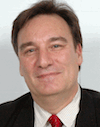
As of Sept. 30, 2013, Jackson National Life—a low-key firm that, unlike some of its competitors, sponsors no national TV advertising during football or basketball games—had sold the most individual variable annuities ($15.5 bn) and the most individual annuities overall ($17.4 bn) in the U.S.
Deliberate sales diets at MetLife, Prudential and elsewhere helped open Jackson’s path to the top. But, by all accounts, the unit of the U.K.’s Prudential plc has succeeded through a tortoise rather than hare approach. The firm relies on its consistent wholesaling, conservative pricing, balanced product mix and an A+ rating from A.M. Best.

Clifford J. Jack (right), executive vice president and head of retail at Jackson, spoke recently with RIJ about his outlook for 2014, a year that opens on the heels of a two-year bull market in equities and which promises tumultuous mid-term elections, the Fed’s ‘taper,’ and a new fiduciary rule from the Department of Labor.
RIJ: What’s the top-of-mind issue for you right now?
Jack: The idea of amnesia has been coming to my mind lately. Retail investors were pretty darn cautious coming out of the financial crisis in 2009. As a result, a lot of them missed most of the run-up. Now they’re jumping into the equity markets as fast as they can. I worry about the retail investor chasing returns.
I don’t disagree with the wisdom of the outflows from fixed income funds. It’s prudent for people to be cautious in a low-rate environment. But I worry about investors becoming too confident.
The worst thing would be to have lost 50% of your retirement assets late in your career, followed by missing the run-up [since 2009] because of caution, followed by the possibility of investing at all-time market highs.
The potential for this kind of whipsaw effect creates an interesting challenge for manufacturers. We have to temper our need to sell products with our knowledge that it’s not the best idea for people to invest when the market is at all-time highs. It’s been interesting to see how quickly things snapped back after the financial crisis, and how quickly people seem to have forgotten what happened.
RIJ: Jack Bogle probably wouldn’t have said it much differently. What’s the outlook for Jackson National in particular?
Jack: Our overarching issue is, what is the next phase of retirement investing? What should it look like? How can we be positioned best to take advantage of it? We believe that the key is diversification, in the entire portfolio, inclusive of the fixed income area. So, we have tried, with some success, to take a leadership position in building out an alternative platform.
RIJ: You’re referring to your Elite Access variable annuity, which doesn’t have a lifetime income rider, but which offers advisers the opportunity to trade so-called alternative investments inside a tax-deferred account.
Jack: That has gone very well for us. We’re a big believer in that. A significant share of the advisers who have sold Elite Access had never done business with Jackson before. That’s very attractive, because we’re picking up share that we didn’t have before. I believe that type of split is extremely common in the brokerage world and not Jackson-specific. We believe in the ‘bifurcation’ of the adviser market.
RIJ: How so?
Jack: One type of adviser likes to say, ‘I’m the expert. Just give me the underlying tools so that I can invest the way I see fit.’ Another type of adviser says, ‘I’m good with people. I’m good at having clients call me at 3 a.m. I want to leave the portfolio construction to you, Mr. Asset Manager.’ We’re happy to do business with both.
RIJ: As I understand it, advisers can access Jackson directly, or through your asset management platform, Curian Capital, right?
Jack: At Curian Capital [Jackson’s wholly-owned managed account provider], you [the adviser] can build your own portfolio out of mutual funds or separate accounts. You can invest in models or you can invest in managed products. The models are ideas, if you will, that you can tailor, by percentages. With the managed products, we do all the work. You can rely on Curian to pick and choose.
On the Jackson side, which is a larger portion of our business, there’s much of the same flexibility. On the VA side of the business, you can go with Perspective II, which has a living benefit, or Elite Access, which doesn’t. With either one, you can pick and choose funds, or a model or a managed portfolio, depending on what’s in the client’s best interest. You have the same ability with Elite Access. You have individual funds, models or managed accounts.
We want to have, as a continued theme, those advisers who want to do it themselves and those who want to outsource. They can do either at Jackson. I’ve not seen many advisers do both.
RIJ: It doesn’t sound like you’re after the most aggressive advisers, however.
Jack: We ask ourselves, how can we construct portfolios so that you miss the big fat tails, even if it means that you’ll leave some money on the table when markets are going straight up. We talk that language every single day, and we think it makes a difference. But it gets hard to tell that story. Over the past year, a properly diversified portfolio didn’t pay out big.
As a company, smoothing out returns is an important theme for us. We’re willing to walk away from those customers who are chasing returns—unless they’re just doing it with their ‘play money.’ We’re seeking clients who want a good return on a risk-adjusted basis.
RIJ: When you say ‘construct portfolios,’ do you mean at the fund level, the VA separate account level or the managed account level?
Jack: All of the above. We have funds, separate accounts and overlays. If you dissect our four major product categories [VAs, fixed annuities, fixed indexed annuities, and managed accounts], in three out of those four we allow you to construct what you want at the platform, portfolio or product level, depending on desire. People want to buy different stuff, so we offer flexibility.
RIJ: It looks like the Fed under Janet Yellen may stop buying bonds and allow bond prices to fall a bit, causing a rise in rates. What are your thoughts on that?
Jack: We’re cautious with respect to interest rates. We believe they may go up, perhaps quickly and dramatically. We want to be in a good position to give the retail investor options that are not exposed to the tail risk of a rising rate environment. We realize that equities aren’t right for all investors, either in retirement or when approaching retirement.
RIJ: That brings up the topic of fixed indexed annuities. They’re still a bit controversial. Some broker-dealers won’t sell them. Or they will only sell certain ones.
Jack: We like that business. Current returns don’t allow us to offer the benefits we’d like to offer, but that may change. If there’s a orderly rise in interest rates, you may see our FIA business participate in that.
In the early years of the FIA business, in the 1990s, we were actually number one. Then we saw a number of things occurring in the marketplace that made us uncomfortable and we chose not to participate. We gave up sales. And now we’re glad we didn’t participate. The question is, ‘Is the product in the best interest of the consumer?’ Some products are not. In parts of the retail business, the clients’ best interests are not being served.
If we weren’t the first organization to do so, we were close to the first to submit all our FIA materials to FINRA for review. We wanted a product that broker/dealers would be proud to sell alongside everything else they sell. We wanted quality disclosure. We never believed in two-tier [installment pay-out] annuities. We never believed in products that don’t have an overall consumer benefit. We’re happy to walk away from business. It’s the Jackson way. If we lose sales, so be it.
RIJ: That doesn’t seem to be a big problem at the moment.
Jack: We’ve always stayed away from discussing rankings or market share. We always said, ‘We’ll get the sales we’re comfortable with.’ We gave up market share before the financial crisis. We always said that we’d like larger sales but not to the detriment of the company.
Now we’re at the top of the heap and we’re comfortable with it because it has worked. It’s an interesting place to be. Look, it’s hard to stress insurance companies’ books of business any harder than they’ve been stressed over the last six years. In that time, we’ve had no write-downs, we have had to raise no capital, and we’ve made money every year. All of our benefits are profitable because we priced them properly.
We haven’t jumped farther up in the league tables on the fixed side because the fixed annuity market isn’t as attractive, and may never again be as attractive, as it once was. We’re much more inclined to write Elite Access business today than to take balance sheet risk with fixed annuities. If somebody leapfrogs us, if they’re more aggressive than we are, we’re comfortable with that.
© 2014 RIJ Publishing LLC. All rights reserved.








 We concluded that the retirement income market was overlooked, and I focused on that. In 1997, we launched a syndicated research initiative on attitudes and perceptions about retirement income. We’ve also concluded a number of proprietary research and consulting engagements for clients on the retirement income opportunity. In 2003, we started the Retirement Management Executive Forum, or RMEF.
We concluded that the retirement income market was overlooked, and I focused on that. In 1997, we launched a syndicated research initiative on attitudes and perceptions about retirement income. We’ve also concluded a number of proprietary research and consulting engagements for clients on the retirement income opportunity. In 2003, we started the Retirement Management Executive Forum, or RMEF.


 This component is primarily driven by investor behavior, and may well be the cause of future economic results rather than being a leading indicator of the economy.
This component is primarily driven by investor behavior, and may well be the cause of future economic results rather than being a leading indicator of the economy.







